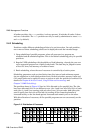
Resource Requests
3.2 Resource Requests
Having logged into the system, a user makes a request for the resources needed to run a
parallel program by using the RMS commands prun (see Page 5-11) or allocate (see
Page 5-3). When using the prun command, the request can specify details such as the
following:
• The partition on which to run the program (the -p option)
• The number of processes to run (the -n option)
• The number of nodes required (the -N option)
• The number of CPUs required per process (the -c option)
• The memory required per process (the RMS_MEMLIMIT environment variable)
• The distribution of processes over the nodes (the -m, -B and -R options)
• How standard input, output and error streams should be handled (the -i, -o and -e
options)
• The project to which the program belongs for accounting and scheduling purposes
(the -P option)
Two variants of a program with eight processes are shown in Figure 3.1: first, with one
process per node; and then, with two processes per node.
Figure 3.1: Distribution of Parallel Processes
1ProcessPerNode
2ProcessesPerNode
0 1 2 3 4 5 6 7
0 1
4 5
2 3
6 7
3-2 Parallel Programs Under RMS


















